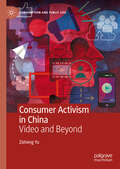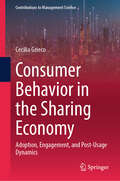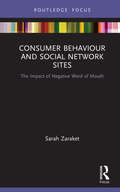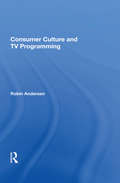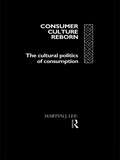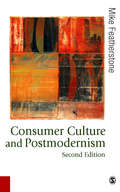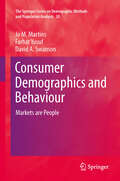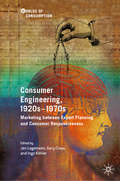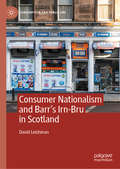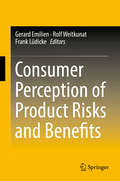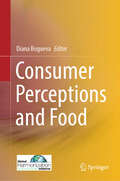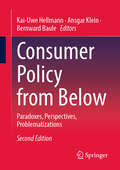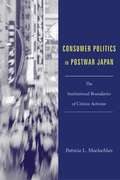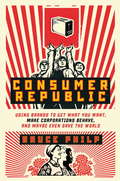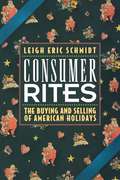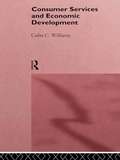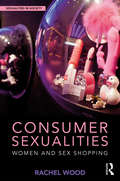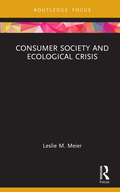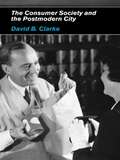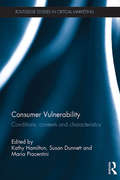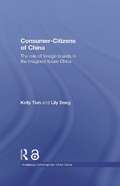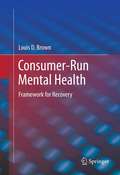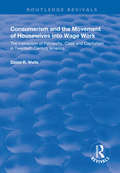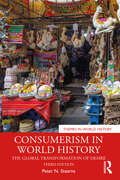- Table View
- List View
Consumer Activism in China: Video and Beyond (Consumption and Public Life)
by Zizheng YuThis book investigates the origins, dynamics and impacts of the different nuances of contemporary short video activism tactics, by merging theories from social movement studies and communication studies including grievances theories, a renewed understanding of the concept of repertoires of contention and a critical media practice approach. It situates this phenomenon in the long durée of consumer activism in both the Global North and the South and demonstrates how short video activism constitutes a vibrant new phase in the historical evolution of activism in the Chinese socio-political context. It will be of interest to students and scholars of social activism, social movement studies, consumer culture studies and media practice.
Consumer Behavior in the Sharing Economy: Adoption, Engagement, and Post-Usage Dynamics (Contributions to Management Science)
by Cecilia GriecoThe book examines the essential aspects of consumer behavior within the sharing economy. This thorough analysis covers the pre-adoption, active usage, and post-adoption phases, offering a comprehensive view of the consumer journey. The research is based on an extensive literature review, highlighting key elements and emphasizing the consumer perspective through original quantitative and qualitative studies across various industries. Researchers will find the theoretical advancements and cutting-edge insights invaluable. Platform managers will gain a deeper understanding of consumer behavior, enabling them to refine strategies throughout the purchasing process. Marketing professors can use this book as a primary textbook or supplementary reading for their courses. Key topics include the drivers of adoption, trust issues, satisfaction, and user retention, along with theoretical frameworks that uniquely define the phenomenon of the sharing economy and the specificities of consumer behavior within this domain.
Consumer Behaviour and Social Network Sites: The Impact of Negative Word of Mouth (Routledge Focus on Business and Management)
by Sarah ZaraketThis book provides a solid understanding of electronic word of mouth (eWOM) by taking the reader through the process of information diffusion from rumour generation in times of traditional word of mouth (WOM) to negative social eWOM and examining how consumers process it. Consumer Behaviour and Social Network Sites tackles different themes relating to negative eWOM. Drawing on both intensive scientific research and professional examples, it bridges the gap between the academic and professional worlds. The book contrasts negative social eWOM to traditional WOM while discussing the specificities of different social networking sites in diffusing such information. It looks at why and how consumers decide to create, share and react to negative social eWOM, suggesting that there are more reasons than are commonly presumed for consumers to articulate themselves on these platforms. It also provides an appreciation of web users' behaviours with regards to negative social eWOM and how it can alter their decision-making journey. The book concludes with several strategies and key takeaways to deal with and prevent negative social eWOM. Most books on WOM are purely professional and lack the theoretical contextualization of the issue. Moreover, they often provide insights on brand-to-consumer conversation but not consumer-to-consumer (C2C) communication. This short book provides marketing academics, students and practitioners with an important insight into these C2C communications that can potentially be harmful to brands.
Consumer Culture And Tv Programming (Critical Studies In Communication And In The Cultural Industries)
by Robin K AndersenProduct placement is now an integral part of what is considered the highest-quality fiction programming on television. Throughout the history of television, until now, direct product placement within fiction has not been a significant marketing strategy. This broadcasting/marketing configuration marks a another definitive step in the history of the commercialization of television. This book is an exploration of the interconnections between media economics and communication discourse. The recessionary, highly competitive economic environment of the 1980s, which affected networks, independent broadcasting, and the media industry in general, has been widely noted in the business pages of the national press. But the dramatic effects on programming wrought by the financial strategies of this period are yet to be understood. Marketing factors account for the heightened emphasis on programming environment during the 1980s. But what are the full implications of the practice of audience marketing and the creation of appropriate programming environments?
Consumer Culture Reborn: The Cultural Politics of Consumption
by Martyn J. LeeFirst published in 1993. Routledge is an imprint of Taylor & Francis, an informa company.
Consumer Culture and Postmodernism (Published in association with Theory, Culture & Society #6)
by Mike FeatherstoneThe first edition of this contemporary classic can claim to have put 'consumer culture' on the map, certainly in relation to postmodernism. This expanded new edition includes: a fully revised preface that explores the developments in consumer culture since the first edition a major new chapter on 'Modernity and the Cultural Question' an update on postmodernism and the development of contemporary theory after postmodernism an account of multiple and alternative modernities the challenges of consumer culture in Japan and China. The result is a book that shakes the boundaries of debate, from one of the foremost writers on culture and postmodernism of the present day.
Consumer Demographics and Behaviour: Markets are People (The Springer Series on Demographic Methods and Population Analysis #30)
by David A. Swanson Farhat Yusuf Jo M. MartinsThis is the book that market strategists have been waiting for to position themselves in global markets and take advantage of the opportunities that demographic bonuses and deficits offer to them and their products. It is also a book for teachers and students of consumer behaviour to grasp the importance of the life cycle as a framework that shapes the demand for goods and services determined by changes in social, economic and physical functioning. It gives insights into gendered consumer behaviour and cohort effects. It presents a range of views on consumer behaviour and how demographic perspectives enhance these perspectives. The book offers conceptual and analytical tools that can be used in the assessment of population characteristics as determinants of market size, composition and potential for a variety of products. It offers organising frameworks as well as empirical evidence of consumer behaviour in clusters of markets, with different rates of population growth and age distribution that affect consumers' priorities and demand for basic and progressive commodities. The book shows commonalities as well as differences in consumer behaviour arising from different cultures and social customs. It uses analytical tools that are explained and accessible to readers with a range of competences. It is a book that can give a better understanding of consumer behaviour and market opportunities to the practitioner. It can also be used for the instruction of students in demography, consumer behaviour and marketing.
Consumer Engineering, 1920s–1970s: Marketing between Expert Planning and Consumer Responsiveness (Worlds of Consumption)
by Gary Cross Jan Logemann Ingo KöhlerIn the middle of the twentieth century, a new class of marketing expert emerged beyond the familiar ad men of Madison Avenue. Working as commercial designers, consumer psychologists, sales managers, and market researchers, these professionals were self-defined “consumer engineers,” and their rise heralded a new era of marketing. To what extent did these efforts to engineer consumers shape consumption practices? And to what extent was the phenomenon itself a product of broader social and cultural forces? This collection considers consumer engineering in the context of the longer history of transatlantic marketing. Contributors offer case studies on the roles of individual consumer engineers on both sides of the Atlantic, the impact of such marketing practices on European economies during World War II and after, and the conflicted relationship between consumer activists and the ideas of consumer engineering. By connecting consumer engineering to a web of social processes in the twentieth century, this volume contributes to a reassessment of consumer history more broadly.
Consumer Nationalism and Barr’s Irn-Bru in Scotland: Iron Nation (Consumption and Public Life)
by David LeishmanThis book connects a detailed analysis of Irn-Bru’s brand identity over time to theories of national identity, consumer studies, and banal nationalism. It situates the commercial history of Barr’s Irn-Bru in a transnational context and shows how Irn-Bru has become a symbol of Scotland through processes of rewriting, reframing and institutionalized forgetting, linking the consumption of what began as a trans-national generic product to a specific national community. As such, Leishman presents a longitudinal, cross-disciplinary approach to analysing branding and advertising as multi-modal forms of discourse, in order to underline the role of commercial, non-state actors and popular consumerism in the phenomenon of banal nationalism. It will be of interest to students and scholars researching nationalism, consumption, and Scottish studies.
Consumer Perception of Product Risks and Benefits
by Gerard Emilien Rolf Weitkunat Frank LüdickeThis book reflects the current thinking and research on how consumers' perception of product risks and benefits affects their behavior. It provides the scientific, regulatory and industrial research community with a conceptual and methodological reference point for studies on consumer behavior and marketing. The contributions address various aspects of consumer psychology and behavior, risk perception and communication, marketing research strategies, as well as consumer product regulation. The book is divided into 4 parts: Product risks; Perception of product risks and benefits; Consumer behavi∨ Regulation and responsibility.
Consumer Perceptions and Food
by Diana BoguevaThis book is a timely overview of the various aspects of consumer perception related to food. This book explores consumer perceptions that are vital to marketers and often underlie the success or failure of products in the marketplace. Perception is the process of selecting, organizing, and interpreting sensations into a meaningful whole, and this book highlights how human perceptions are unique, highly subjective, and easily distorted. These perceptions are influenced by our senses—sight, hearing, taste, smell, and touch—as well as our beliefs, emotions, opinions, and experiences. This book states that this is related to food, and perceptions are also guided by beliefs, thoughts, emotions, feelings, and opinions about, or preferences, expectations, and knowledge of, and the sensory experience, the fear, and the relationships built between the consumers and the food over time. This book aims to further the understanding of the fundamental mechanisms which determine individual responses to existing and emerging food issues. This book provides insights into consumer behaviour (e.g. consumer decision making, promoting behaviour change), factors influencing consumers’ food and meal choices, confidence in the safety of food, perception of health-related messages and food laws and regulations, sustainable and responsible consumer behaviour (e.g. food waste), acceptability of new food alternatives, innovations and technologies, integrating consumer insight and communication challenges in cross-functional communications in innovation processes. "Consumer Perceptions and Food" delves into how these perceptions shape consumer behavior, from decision-making and behavior change to meal choices and confidence in food safety. It explores the impact of health-related messages, food laws, and regulations, and examines the acceptability of new food alternatives and technologies. The book also addresses the importance of sustainable and responsible consumer behavior, including food waste and ethical consumption. Through a rich array of insights, this book provides a deep understanding of the fundamental mechanisms that drive individual responses to food issues. It emphasizes the importance of mindful eating—making conscious food choices that benefit our health, the environment, and the planet. This involves considering the origins of our food, its production methods, and the broader impacts of our choices on public health and ecosystems. This book is a call to action for consumers to rethink their relationship with food, fostering deeper connections and appreciation for sustainable practices and ethical consumption. It is a crucial step in the ongoing journey of shaping the future of food, guided by informed and mindful consumers.
Consumer Policy from Below: Paradoxes, Perspectives, Problematizations
by Ansgar Klein Kai-Uwe Hellmann Bernward BauleSince its existence in the 1950s, consumer policy in Germany has been understood and pursued primarily as a bundle of actions and measures initiated and institutionalised by the state. In many cases, the state has also issued corresponding mandates and set up support models, which has created the impression that we are basically dealing with a 'consumer policy from above' imposed by macro-politics. Not that there have not been repeated attempts in the past decades to give impetus to consumer policy from the middle of civil society - often in the form of small citizens' initiatives. And in recent years in particular, a number of new consumer organisations have emerged which operate much closer to the grass roots. Nevertheless, the impression seems to have taken root among the large, government-related 'players' in the field, who have been in the 'business' for decades, not to mention government-internal consumer policy, that consumer policy concerns a policy field that is essentiallyordered by a collaboration of the state on the one hand, and consumer protection organisations representing all consumers equally on the other, while the many small consumer initiatives, not even started by individual committed consumers, regularly fall behind in comparison. This perspective refers largely to the view of and from the centre of politics. This volume is intended to go some way towards countering the institutionally prevailing impression that, in principle, there is only 'consumer policy from above' that is really effective and assertive.The translation was done with the help of artificial intelligence. A subsequent human revision was done primarily in terms of content.
Consumer Politics in Postwar Japan: The Institutional Boundaries of Citizen Activism (Studies Of The East Asian Institute (coup) Ser.)
by Patricia MaclachlanProviding comparisons to the United States and Britain, this book examines Japan's postwar consumer protection movement. Organized largely by and for housewives and spurred by major cases of price gouging and product contamination, the movement led to the passage of basic consumer protection legislation in 1968. Although much of the story concerns the famous "iron triangle" of big business, national bureaucrats, and conservative party politics, Maclachlan takes a broader perspective. She points to the importance of activity at the local level, the role of minority parties, the limited utility of the courts, and the place of lawyers and academics in providing access to power. These mild social strategies have resulted in a significant amount of consumer protection.
Consumer Republic
by Bruce PhilpConsumer Republic dares you to consider this: The power to save the world lies with the consumer. The foundation of Bruce Philp's message is this single, inarguable truth: Brands make corporations accountable. They are the only leverage the average consumer has with which to make a company behave itself. Expensive to create, essential to making money, and more public than anything else a corporation has or does, a brand is an enormously valuable and fragile asset to them. And we consumers have the power to make it worthless. As someone who has worked on the inside, Philp knows exactly how this power can be made to work for us. Through this book he will inspire you to make every dollar you spend count. To buy less, maybe, but demand better. To make better choices. And then to speak up when you're happy and when you're not. Pin every one of these acts to a brand, Consumer Republic promises, and corporations will be forced to cooperate in making our way of life sustainable. Abandon brands, and we'll surrender the marketplace to scoundrels. Take control of them, and we can save the world.From the Hardcover edition.
Consumer Rites: The Buying and Selling of American Holidays
by Leigh Eric SchmidtSlogans such as "Let's put Christ back into Christmas" or "Jesus is the Reason for the Season" hold an appeal to Christians who oppose the commercializing of events they hold sacred. However, through a close look at the rise of holidays in the United States, Leigh Schmidt show us that commercial appropriations of these occasions were as religious in form as they were secular. The rituals of America's holiday bazaar that emerged in the nineteenth century offered a luxuriant merger of the holy and the profane--a heady blend of fashion and faith, merchandising and gift-giving, profits and sentiments, all celebrations of a devout consumption. In this richly illustrated book, which captures both the blessings and ballyhoo of American holiday observances for the mid-eighteenth century through the twentieth, the author offers a reassessment of the "consumer rites" that various social critics have long decried for their spiritual emptiness and banal sentimentality.
Consumer Services and Economic Development
by Colin C. WilliamsConsumer Services have been viewed as parasitic activities, dependent on other sectors of the economy for their viability and vitality. Yet local economic policy is now looking towards consumer services to solve severe economic problems. The rapid expansion of the service sector is now a principal feature of contemporary global economic restructuri
Consumer Sexualities: Women and Sex Shopping (Sexualities in Society)
by Rachel WoodConsumer Sexualities explores women’s experiences of shopping in ‘sex shops’ and using sexual commodities in their everyday lives. This enlightening volume shows how women take up sexual consumer ‘technologies of the self’ to work upon and understand themselves as confident and active sexual agents in postfeminist neoliberal culture. In guiding the reader through the historical emergence of sexual commodities ‘for women’ in feminism and postfeminism, Wood points to the normalisation and regulation of sexual practices and identities in and through consumption. Indeed, women’s accounts show the work involved in constructing the ‘right’ – knowledgeable, tasteful, and confident – orientation to sexual consumption and, by extension, in becoming an intelligibly ‘good’ sexual person. At the same time, the author draws upon de Certeau to show how the ordinary contexts in which sexual commodities are used can lead to unpredictable moments of adaptation, discomfort, playfulness, and resistance. A rich analysis of women’s everyday strategies of ‘making do’ with the kinds of femininity and female sexuality that sex shop culture represents, Consumer Sexualities will appeal to scholars of sociology, cultural studies and gender studies with interests in gender, sexuality, sex, and consumption.
Consumer Society and Ecological Crisis (Routledge Critical Advertising Studies)
by Leslie M. MeierConsumer Society and Ecological Crisis advances a critique of consumer capitalism and its role in driving environmental degradation and climate crisis, placing a spotlight on how marketing and distribution activities help maintain unsustainable levels of consumption. Rather than focusing on the most visible sites of promotional communication, Meier examines less conspicuous facets of marketing and logistics in distinct chapters on plastic packaging, e-commerce, and sustainability pledges in the fossil fuel sector. These three main chapters each explore links between ecological crisis and consumer capitalism, drawing on critical theory and Marxist thought. The topics of consumer convenience, speed, and economic growth – and the role of fossil fuels as guarantor of these logics of consumer society – unite the critical analysis. Situated in the field of media and communication studies and adopting an interdisciplinary approach, this book will be of interest to academics, researchers, and students in the areas of media and communication studies, cultural studies, sociology, geography, philosophy, political science, and advertising.
Consumer Society and the Post-modern City
by David B ClarkeThe fact that we inhabit a consumer society has incredibly far-reaching implications. Working through the often controversial ideas of the consumer society's most influential theorists, Jean Baudrillard and Zygmunt Bauman, this book assesses the ways in which consumerism is reshaping the nature and meaning of the city. It examines the nature of consumption and its increasing centrality to post-modern society by;*considering the development of consumerism as a central facet of social life*demonstrating that social inequalities are increasingly structured around consumption*uncovering the hidden consequences of consumerism*pondering the meaning of lifestyle*revealing how the nature of reality is changing in an age of globalization.Employing a sustained and engaging theoretical analysis, the book ranges across a variety of sometimes unexpected topics. It represents an impassioned plea for everyone interested in the social life of cities to take the notion of the consumer society - and the arguments of its major theorists - seriously.
Consumer Vulnerability: Conditions, contexts and characteristics (Routledge Studies in Critical Marketing)
by Kathy Hamilton Susan Dunnett Maria PiacentiniConsumer vulnerability is of growing importance as a research topic for those exploring wellbeing. This book provides space to critically engage with the conditions, contexts and characteristics of consumer vulnerability, which affect how people experience and respond to the marketplace and vice versa. Focussing on substantive, ethical, social and methodological issues, this book brings together key researchers in the field and practitioners who work with vulnerability on a daily basis. Organised into 4 sections, it considers consumer vulnerability and key life stages, health and wellbeing, poverty, and exclusion. Methodologically the chapters draw on qualitative research, employing a variety of methods from interview, to the use of poetry, film and other cultural artefacts. This book will be of interest to marketing and consumer research scholars and students and also to researchers in other disciplines including sociology, public policy and anthropology, and practitioners, policy makers and charitable organisations working with vulnerable groups.
Consumer-Citizens of China: The Role of Foreign Brands in the Imagined Future China (Routledge Contemporary China Series)
by Kelly Tian Lily DongA PDF version of this book is available for free in open access via www.tandfebooks.com as well as the OAPEN Library platform, www.oapen.org. It has been made available under a Creative Commons Attribution-Non Commercial-No Derivatives 3.0 license and is part of the OAPEN-UK research project. This book presents a comprehensive examination of Chinese consumer behaviour and challenges the previously dichotomous interpretation of the consumption of Western and non-Western brands in China. The dominant position is that Chinese consumers are driven by a desire to imitate the lifestyles of Westerners and thereby advance their social standing locally. The alternative is that consumers reject Western brands as a symbolic gesture of loyalty to their nation-state. Drawing from survey responses and in depth interviews with Chinese consumers in both rural and urban areas, Kelly Tian and Lily Dong find that consumers situate Western brands within select historical moments. This embellishment attaches historical meanings to Western brands in ways that render them useful in asserting preferred visions of the future China. By highlighting how Western brands are used in contests for national identity, Consumer-Citizens of China challenges the notion of the "patriot’s paradox" and answers scholars’ questions as to whether Chinese nationalists today allow for a Sino-Western space where the Chinese can love China without hating the West. Consumer-Citizens of China will be of interest to students and scholars of business studies, Chinese and Asian Studies and Political Science. Kelly Tian is Professor of Marketing and holds the Anderson Chair of Business at New Mexico State University. Lily Dong is Associate Professor of Marketing at the University of Alaska at Fairbanks.
Consumer-Run Mental Health: Framework for Recovery
by Louis D. BrownConsumer-run organizations and other types of mental health self-help are becoming increasingly popular in the public mental health system. These initiatives now outnumber traditional mental health organizations in the US (Goldstrom et al., 2006). This growth is due in large part to their low cost, devoted supporters, burgeoning evidence base, and increased acceptance by mental health professionals. International interest in these initiatives is also growing as self-help is flourishing in industrialized countries worldwide. I recently edited a special issue on mental health self-help for the American Journal of Community Psychology and we received submissions from five continents, with exciting work coming out of China, Australia, and Europe. The proposed book develops a rich theoretical model called the Role Framework, which explains how people engage in and benefit from mental health consumer-run organizations (CROs).
Consumerism and the Emergence of the Middle Class in Colonial America
by Christina J. HodgeThis interdisciplinary study presents compelling evidence for a revolutionary idea: that to understand the historical entrenchment of gentility in America, we must understand its creation among non-elite people: colonial middling sorts who laid the groundwork for the later American middle class. Focusing on the daily life of Widow Elizabeth Pratt, a shopkeeper from early eighteenth-century Newport, Rhode Island, Christina J. Hodge uses material remains as a means of reconstructing not only how Mrs. Pratt lived, but also how these objects reflect shifting class and gender relationships in this period. Challenging the "emulation thesis," a common assumption that wealthy elites led fashion and culture change while middling sorts only followed, Hodge shows how middling consumers were in fact discerning cultural leaders, adopting genteel material practices early and aggressively. By focusing on the rise and emergence of the middle class, this book brings new insights into the evolution of consumerism, class, and identity in colonial America.
Consumerism and the Movement of Housewives into Wage Work: The Interaction of Patriarchy, Class and Capitalism in Twentieth Century America (Routledge Revivals)
by David R. WellsFirst published in 1998, this volume explores the connections between the rises in consumerism and the number of married women in paid work in light of the centrality of shopping and consumerism to the modern world. David R. Wells argues for women’s incomplete gains from consumerism through an analysis of married women’s employment, the structure of capitalism and the contradictory requirements of consumerism, the homemaker ideal and gender identity. Through this, Wells demonstrates how the gendered expectations of consumerism became motivating factors for women to join the workforce, resulting in higher standards of living and greater marital power.
Consumerism in World History: The Global Transformation of Desire (Themes in World History)
by Peter N. StearnsThe third edition of Consumerism in World History explores the nature of consumerism and its evolution, with particular emphasis on the modern “consumer revolution” and its global scope.The book deals with crucial interpretive issues, such as whether consumerism is a natural human expression or involves other causes, the relationship between consumer apparatus (such as shops and advertising) and human needs, and the interplay between Western and other regional forms of consumerism. It covers major historical moments and changes, including the consumer revolution in Western society beginning in the 17th century and regional cultural patterns from the 19th century onward. This is a substantially revised edition, with updated suggested readings, rewritten sections on premodern consumerism in agricultural societies, and globalization and consumerism, and expanded coverage of major regions like India and Latin America.This volume is essential reading for all students of world history and will be of great value to those in business history and environmental history.
